No products in the cart.
We deliver to
🇺🇸 USA · 🇨🇦 Canada · 🇮🇹 Italy · 🇵🇱 Poland · 🇮🇪 Ireland ·
🇬🇧 United Kingdom · 🇳🇿 New Zealand · 🇯🇵 Japan · 🇨🇭 Switzerland ·
🇮🇱 Israel · 🇲🇽 Mexico · 🇦🇺 Australia · 🇨🇿 Czechia · and more
We deliver to
🇺🇸 USA · 🇨🇦 Canada · 🇮🇹 Italy · 🇵🇱 Poland · 🇮🇪 Ireland ·
🇬🇧 United Kingdom · 🇳🇿 New Zealand · 🇯🇵 Japan · 🇨🇭 Switzerland ·
🇮🇱 Israel · 🇲🇽 Mexico · 🇦🇺 Australia · 🇨🇿 Czechia · and more
[category_image]
Combigrip tablets 80 pieces
$57.80
Combigrip is a line of combined medicines used for the symptomatic treatment of colds and flu. The drug contains paracetamol, which reduces fever and eliminates pain, and phenylephrine, a vasoconstrictor, which reduces swelling of the mucous membrane and facilitates breathing. The tablets, in addition to the above active ingredients, contain caffeine, which stimulates the central nervous system and respiratory center, reducing drowsiness and fatigue. Combigrip Dexa also contains dextromethorphan hydrobromide, which suppresses the cough center, thanks to which dry cough does not cause much discomfort.
Categories: Cold and flu, Pain relief
Brand: Organosyn
Pharmacological properties
Pharmacodynamics. Paracetamol (Combigrip, Combigrip Dexa) is an analgesic and antipyretic. The analgesic and antipyretic effect of paracetamol is associated with the effect of the drug on the thermoregulation center in the hypothalamus and the ability to inhibit the synthesis of prostaglandins.
Caffeine (Combigrip, Combigrip Dexa) is a CNS stimulant. Stimulates the respiratory center, which increases the speed and depth of oxygen saturation of the lungs, increases skeletal muscle tone, and reduces the threshold of hypercapnia. To obtain the same effect when using an analgesic without caffeine, a dose is required that is approximately 40% higher than 1 dose in combination with caffeine. Thus, caffeine is used as an adjuvant for paracetamol.
Phenylephrine hydrochloride (Combigrip, Combigrip Dexa) stimulates postsynaptic α-adrenoreceptors, constricts pulmonary vessels and increases pressure in the pulmonary artery. As a vasoconstrictor, it has an anticongestive effect: it reduces swelling and hyperemia of the nasal mucosa, the severity of exudative manifestations, and restores free breathing.
Chlorpheniramine maleate (Combigrip, Combigrip Dexa) is an H1 – blocker that inhibits the reaction of smooth muscles to histamine. It has an antiallergic effect, reduces tearing and itching of the nasal mucosa.
Dextromethorphan hydrobromide (Combigrip Dexa) is a centrally acting antitussive. It suppresses the cough center by acting directly on it and increases the threshold of sensitivity of the cough center to irritating agents.
Menthol (Combigrip ointment) has a local irritating, analgesic, distracting, antipruritic, antiseptic, sedative effect. The effect is mainly due to reflex reactions associated with irritation of sensitive nerve endings: irritation of skin receptors stimulates the formation and release of endogenous biologically active substances (enkephalins, endorphins, peptides, kinins), which are involved in the regulation of pain, vascular permeability and other processes that provide analgesic, distracting and antipruritic effects. Antiseptic activity is manifested by indiscriminate damage to microbial cells. The irritating (distracting) effect helps to reduce pain. The local effect is accompanied by vasoconstriction, a feeling of cold, which is replaced by a feeling of slight burning and tingling. Cutaneous-visceral reflexes (the reflex arc passes through the brain) improve tissue trophism (according to the innervation zones). The tone of vessels, both superficial and deep in tissues and internal organs, changes reflexively.
Camphor (Combigrip ointment) has an antiseptic, local irritant, analgesic, antiplatelet effect. Reflexively stimulates the vasomotor and respiratory centers, exhibiting analeptic activity. Has peripheral vasopressor activity. Inhibits platelet aggregation. Excreting from the body through the respiratory tract, it promotes expectoration of sputum. When applied topically, it has a distracting effect.
Thymol (Combigrip ointment) is an antiseptic and disinfectant. Destroying enzymes important for the viability of microorganisms, it prevents the spread of the putrefactive process and delays it at the very beginning. Thymol is used in the form of inhalation for bronchitis and other respiratory diseases accompanied by sputum secretion. It stimulates the mucous membranes of the respiratory organs, reduces sputum secretion, thins it, significantly reduces the amount of mucus in it, eliminates the specific odor, prevents excessive secretion, thus preventing sepsis.
Methyl salicylate (Combigrip ointment) has anti-inflammatory, analgesic effects. It non-selectively inhibits COX, reduces prostaglandin synthesis. Normalizes increased capillary permeability, improves microcirculation, reduces swelling and infiltration of inflamed tissues.
Eucalyptus oil (Combigrip ointment) has an antiseptic and disinfectant effect. When applied topically, it reduces sensitivity. Eucalyptus oil also stimulates cardiac activity.
Turpentine oil (Combigrip ointment) is used topically as a distracting and warming agent.
Pharmacokinetics. Paracetamol (Combigrip, Combigrip Dexa) is rapidly absorbed in the gastrointestinal tract, binds to plasma proteins. The half-life from plasma is 1-4 hours. It is metabolized in the liver with the formation of paracetamol glucuronide and sulfate. It is excreted by the kidneys mainly in the form of conjugation products, 5% is excreted unchanged.
Caffeine (Combigrip, Combigrip Dexa) and its water-soluble salts are rapidly absorbed in the intestine (including the colon). The half-life from blood plasma is about 5 hours, in some individuals – up to 10 hours. The main part is demethylated and oxidized. About 10% is excreted by the kidneys unchanged. In the body of full-term newborns and older children (1.5-2 months) it is eliminated more slowly (the half-life is from 80 to 26.3 hours, respectively).
Phenylephrine hydrochloride (Combigrip, Combigrip Dexa) has low bioavailability due to uneven absorption and the effect of monoamine oxidase in the gastrointestinal tract and liver during the first pass. It is excreted by the kidneys in the form of metabolites. At acidic pH of urine, excretion from the body is accelerated.
Chlorpheniramine maleate (Combigrip, Combigrip Dexa) is a component that reduces the severity of the characteristic effects of histamine, which is especially important in preventing and alleviating many allergic symptoms. It is absorbed relatively slowly in the gastrointestinal tract, the maximum concentration in the blood plasma is reached from 2.5 to 6 hours after oral administration. Bioavailability is low and is 25-50%. Chlorpheniramine undergoes metabolism during the first passage in the liver. Chlorpheniramine maleate is largely metabolized in the liver with the formation of the metabolites desmethyl and didesmethylchlorpheniramine. About 70% of it binds to plasma proteins. Chlorpheniramine is distributed throughout the body, passes through the blood-brain barrier. In unchanged form and in the form of metabolites, it is excreted mainly in the urine; excretion depends on the pH of the urine and the excretory function of the kidneys. Traces are found in feces. Duration of action is 4-6 hours. More rapid and extensive absorption, more rapid elimination, and a shorter half-life have been noted in children.
Dextromethorphan hydrobromide (Combigrip, Combigrip Dexa) is rapidly absorbed from the gastrointestinal tract. It is metabolized in the liver and excreted in the urine as unchanged dextromethorphan and as demethylated metabolites, including dextrorphan, which suppresses cough. The half-life of dextromethorphan hydrobromide is 4 hours.
Combigrip ointment
After absorption, menthol is biotransformed in the liver and excreted in urine and bile in the form of glucuronides.
Camphor is readily absorbed from all application surfaces, hydroxylated in the liver to hydroxycamphor metabolites that bind to glucuronic acid, and excreted in the urine. Camphor crosses the placenta.
Methyl salicylate rapidly penetrates the deep layers of the skin, is absorbed, hydrolyzed, converted to the anion of salicylic acid and excreted in the urine. The clearance of salicylates depends on the pH of the urine.
Indication
Combiflu: symptomatic therapy for influenza and acute respiratory viral infections.
Combigrip Dexa: symptomatic therapy of influenza and acute respiratory viral infections (hyperthermia, headache, rhinitis, cough) in adults and children over 6 years of age.
Combigrip ointment:
inflammatory diseases of the respiratory tract (rhinitis, pharyngitis, laryngitis, tracheitis);
myalgia;
arthralgia.
Application
Combigrip
Adults and children over 12 years of age: 1-2 tablets up to 4 times a day.
Children aged 6-12 years: 1/2 -1 tablet 3-4 times a day. It is necessary to observe the interval between doses of at least 4 hours.
The drug is taken at least 30 minutes after a meal.
The duration of treatment is no more than 7 days.
Combigrip Dexa
Adults and children over 12 years of age: 1 tablet up to 4 times a day, with an interval of at least 3-4 hours.
Children aged 6-12 years: 1/2 tablet 4 times a day.
The drug is taken at least 30 minutes after a meal.
The duration of treatment is no more than 7 days.
Combigrip ointment
For respiratory diseases, apply a thick layer to the skin in the chest and neck area and rub in. If desired, the application area can be covered with a warm, dry cloth, but it should be applied loosely to allow the vapors to reach the nose and throat.
For muscle and joint pain, apply a thick layer to the muscle or joint area and rub in gently.
In adults and children aged 2-12 years, the drug is used up to 3 times a day or as prescribed by a doctor.
Duration of treatment – no more than 7 days. If the symptoms of a cold do not disappear, the use of the drug should be discontinued.
Contraindication
Alcoholism, prostatic hypertrophy, severe forms of atherosclerosis, hypertension, acute pancreatitis and hepatitis, peripheral arterial thrombosis, severe forms of coronary artery disease, cardiac conduction disorders, ventricular tachycardia, hypersensitivity to the components of the drug, simultaneous administration with MAO inhibitors, children under 6 years of age.
Combigrip ointment: epilepsy or increased seizure susceptibility, as strong odors can trigger a seizure; children under 2 years of age; pregnancy, as camphor and eucalyptus oil easily penetrate the skin and placental barrier.
Side effects
Agranulocytosis, thrombocytopenia, anemia, renal colic, aseptic pyuria, interstitial glomerulonephritis, allergic reactions. Also possible are anxiety, agitation, insomnia, drowsiness, dizziness, confusion, tachycardia, arrhythmia, increased blood pressure, nausea, vomiting, decreased appetite, diarrhea, constipation, pain in the epigastric region.
Combigrip ointment. Moderate local irritation, erythema, rash, peeling and itching of the skin in the area of application of the ointment are possible. There may also be a moderate transient change in skin color and the appearance of stains on the fabric.
Menthol may cause hives, erythema, or other skin lesions (dermatitis).
With prolonged use, sensitivity to the drug and the analgesic effect may decrease.
Special instructions
Combigrip, Combigrip Dexa. Before using the drug, you should make sure that the main cause of the cough is determined and that reducing the intensity of the cough will not lead to an increased risk of developing complications. The drug may reduce the speed of reaction when driving or working with mechanisms. Phenylephrine may cause tachycardia, dizziness or a feeling of increased heartbeat; patients should be warned about this.
The use of the drug during pregnancy is not recommended. The effect of the drug during breastfeeding has not been studied.
Use with caution in liver, heart and vascular diseases, and alcoholism.
During treatment with the drug, alcohol consumption should be avoided.
Combigrip ointment. Avoid contact with eyes and mucous membranes.
In case of local irritation, the use of the drug is discontinued and appropriate therapy is applied.
The drug should only be applied to intact skin; it should not be applied to open wounds.
Do not use the drug in children to lubricate the nasopharynx.
A persistent cough may be a sign of a serious illness. If the cough does not go away within 1 week, recurs, or is accompanied by fever, rash, or persistent headache, the treatment strategy should be reviewed.
Do not use the drug for prolonged or chronic cough in smokers, asthma, emphysema, or if the cough is accompanied by copious sputum production.
Do not apply the drug to large areas of skin.
The drug is not recommended for use during breastfeeding.
Interactions
Combigrip. If combination therapy is intended, the dosage of one or both drugs should be reduced. The interaction features of the drug are due to the properties of its components.
Caffeine increases the effect of indirect anticoagulants (coumarin derivatives) and the likelihood of liver damage by hepatotoxic drugs. Metoclopramide increases, and cholestyramine reduces the rate of absorption. Barbiturates reduce the antipyretic effect of paracetamol.
Caffeine reduces the effect of sleeping pills and narcotics, increases (by improving bioavailability) – acetylsalicylic acid, paracetamol and other non-steroidal anti-inflammatory drugs. Improves the absorption of ergotamine in the digestive tract.
The use of phenylephrine with other sympathomimetic amines and MAO inhibitors may lead to an additional increase in blood pressure. MAO inhibitors may prolong the anticholinergic effect of antihistamines. Alpha-blockers (phentolamine), phenothiazines, furosemide and other diuretics prevent vasoconstriction.
Incompatibility of chlorpheniramine maleate with calcium chloride, kanamycin sulfate, noradrenaline, and phenobarbital has been noted.
Combigrip Dexa. The use of dextromethorphan hydrobromide with enzyme inhibitors, including amiodarone, fluoxetine, haloperidol, paroxetine, propafenone and thioridazine, may affect cognitive function.
There are no reports of interactions between Combigrip ointment and other medicines.
Overdose
Symptoms of overdose are due to the properties of the individual components of the drug.
Paracetamol in high doses causes hepatonecrosis. Clinical and biochemical signs of liver damage appear after 24-72 hours: increased activity of hepatic transaminases, hyperbilirubinemia and decreased prothrombin levels. Manifested by anorexia, nausea, vomiting, abdominal pain, pallor of the skin.
Caffeine overdose is manifested by feelings of anxiety, restlessness, tremors, headache, confusion, and extrasystole.
Overdose of phenylephrine hydrochloride is manifested by ventricular extrasystole and paroxysms of ventricular tachycardia, a feeling of heaviness in the head and limbs, and a significant increase in blood pressure.
In case of overdose with chlorpheniramine maleate, the mental state may vary from depressed to excited (restlessness and convulsions). Atropine-like symptoms may be observed.
Combigrip Dexa. Overdose of dextromethorphan hydrochloride may manifest as agitation and mental disorders. In very high doses, it may cause respiratory depression.
Treatment: gastric lavage, administration of N-acetylcysteine, symptomatic therapy.
Combigrip ointment. Possible increased severity of side effects, ataxia, drowsiness, reflex respiratory arrest.
Storage conditions
In a dry place, protected from light at a temperature of 15-25 ° C. Combigrip ointment Do not freeze.
Be the first to review “Combigrip tablets 80 pieces” Cancel reply
You may also like



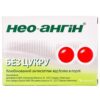



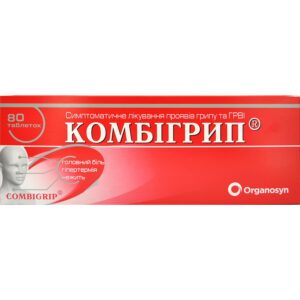
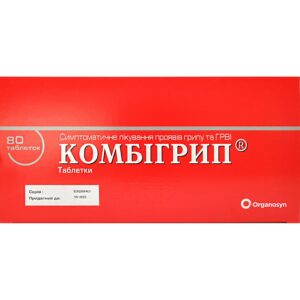
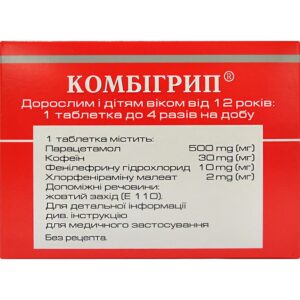
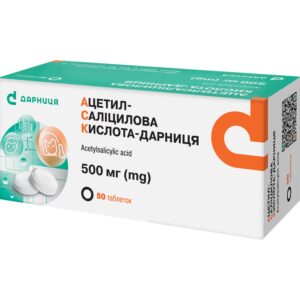
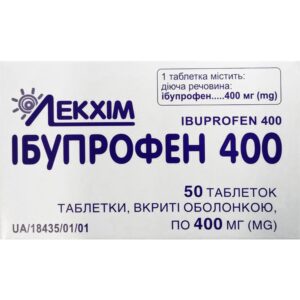
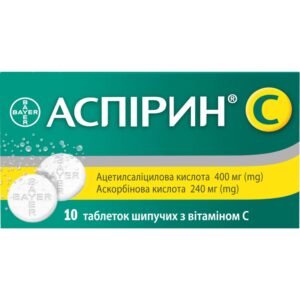
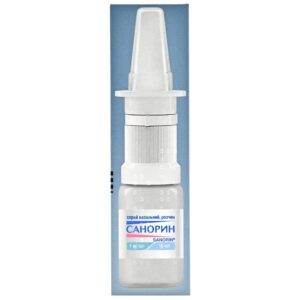
Reviews
There are no reviews yet.